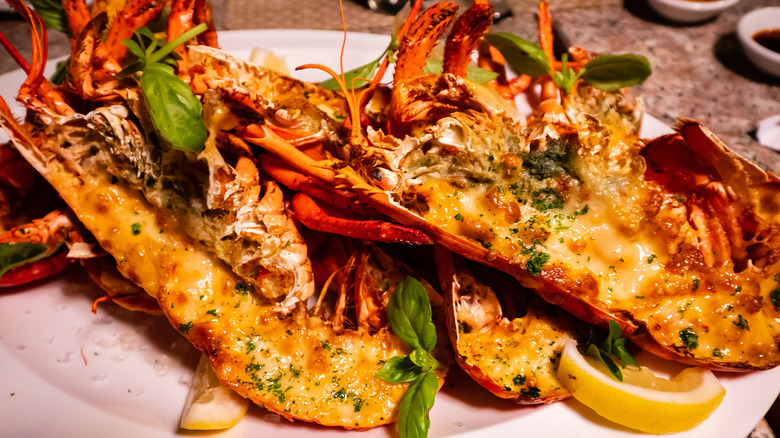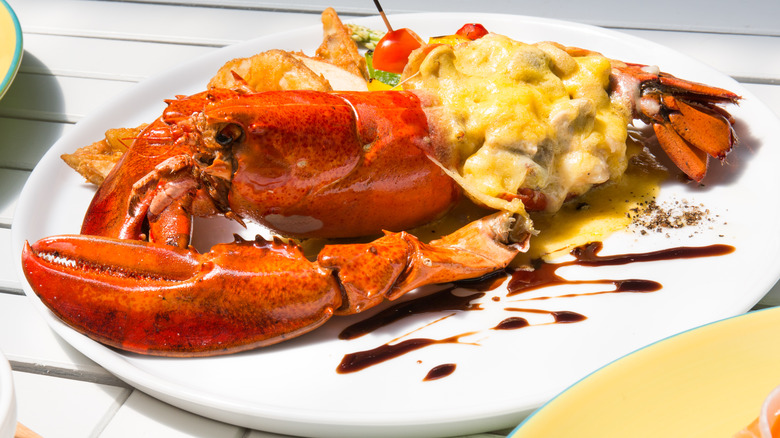Lobster Thermidor's Conflicting Origin Stories
If you're looking for decadence in a dish, Lobster Thermidor is it. You won't just find succulent, spendy lobster; you'll find it dressed up with rich ingredients and a luxe presentation. It's never going to be inexpensive, but it's certainly going to be memorable. The dish takes time to prepare, which is why it often marks a special occasion or serves as a treat when ordering out.
What is Lobster Thermidor? When it's placed in front of you, you'll see the shell of the lobster tail filled with glistening chunks of lobster meat served in a sauce that typically contains lobster stock, cream, white wine, a splash of cognac, flavorings like dijon mustard, and sometimes mushrooms. Before serving, all the lobster meat and luscious sauce is spooned into the lobster tail, topped with cheese — often gruyere – then broiled until it's golden brown.
While you may find variations on the classic Lobster Thermidor, the dish is so distinctive and iconic, you might assume there's one simple story about how and when it was created. In fact, Lobster Thermidor has mysterious origins.
Napoleon Bonaparte was a lobster fan
To say that the French Revolution, which according to History began in 1789 and ended in 1799, was a period of extraordinary upheaval is a bit of an understatement. The entire structure of the government was reimagined and reconfigured, a contentious process resulting in the execution by guillotine of both King Louis XVI and his wife Marie-Antoinette for treason. There were riots, the Reign of Terror, widespread food shortages, and even an entirely new calendar, based not on reverence for saints and royalty but an appreciation of the natural world, with months named, according to Brittanica, after seeds, fruits, harvest, and flowers.
But about that lobster? During Napoleon's rise to power, both The Fish Society and Prime Steak & Seafood explain that the diminutive general named one month to commemorate the time when he first tasted and loved this delicious lobster preparation. That month, the eleventh in the French Republican Calendar, was called Thermidor, named because it's one of the hottest of the year in France, as it stretched from July 19 to August 17 based on our modern calendar.
Interestingly, Emperor Napoleon I abandoned the Republican Calendar in 1806. There appears to be little hard evidence of this perhaps-apocryphal connection between Lobster Thermidor and Napoleon, though the origin story is frequently told.
Lobster Thermidor may have been named for a prohibited play
French Historical Studies recounts the brief furor in 1891 in Paris following the opening of a play called Thermidor, penned by Victorien Sardou, a play that the audience perceived, according to Steven Beaudoin, as critical of the French Revolution. After just three days, further performances of the play were prohibited by the government, at least on state-sponsored stages.
Again ... back to the lobster. The original preparation of Lobster Thermidor, reputed to be named for the controversial play and its equally controversial prohibition, is attributed to a couple of different Paris restaurants. Chez Marie is the front-runner, according to Prime Steak & Seafood and a number of other sources, though Downton Abbey Cooks notes that the dish is also credited to Cafe de Paris.
It's worth noting that a number of origin stories say Lobster Thermidor was created at Chez Marie in 1894 to celebrate the opening of the play, though after the play was banned in 1891 it wouldn't reopen again until 1896. Regardless of which origin story you prefer — Napoleon's love of the dish or its commemoration of a scandalous play — its connection to the French Revolution is baked into the name.


